

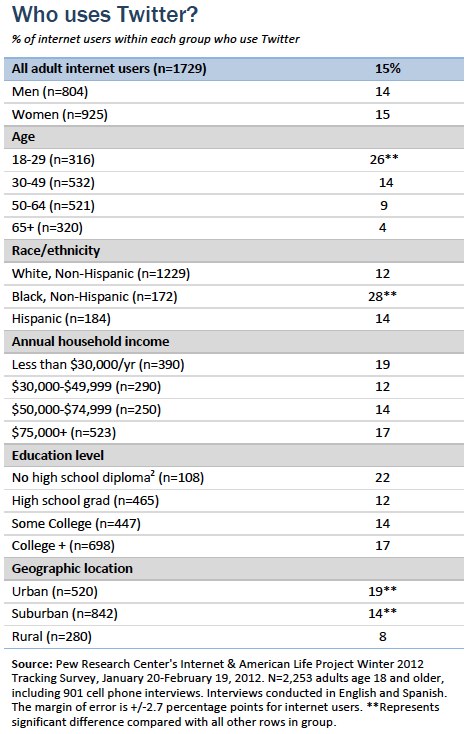
Click read more to view large picture
Pew have updated their annual look at who is using Twitter – you may recall that in their 2011 report it was revealed that some 13 percent of online adults were using the micro-blogging platform (up from 8 percent in 2010), and that the typical user skewed towards an 18-29 year-old non-white male.
Fast-forward another year, and what has changed?
Not much, to be honest. While Pew’s latest findings reveal that overall Twitter usage is up a couple of percentage points to 15 percent of online adults, the service still performs strongly with minorities, with more than one quarter of black internet users (28 percent) and 14 percent of Hispanic users active on the platform. Conversely, just 12 percent of whites use Twitter.
The 18-29 demographic continues to be the most highly represented at 29 percent, ahead of those aged 30-49 (14 percent) and 50-64 (9 percent).
The only notable difference: women (15 percent) have taken the lead from men (14 percent), albeit marginally.
Did you know that the number one reason why somebody unfollows you on Twitter is because you are making too much noise?
That is, sending out too many tweets that contain little or no “signal”. In a recent multiple answer study, 52 percent of respondents chose this as their top reason, ahead of too much self-promotion (48 percent), posting spam (47 percent), being uninteresting (43 percent) and too much repetition (29 percent).
These, and ten other main reasons why you’re getting unfollowed (alongside a lot of minor ones), can be found in this infographic from the Marketing Tech Blog, who used data taken from an Econsultancy survey.

Read more to view the picture in large
By Carl Anderson
For months America’s bishops have attempted to work with the current Administration to ensure adequate First Amendment religious freedom protection of religious organizations. They have been rebuffed each time, the United States Conference of Catholic Bishops formally responded to proposed rules in the HHS mandate on May 15.
Our bishops’ response shows how easy it would be for the administration to make real progress on this issue, and how the federal regulations being implemented conflict with the cherished history of First Amendment liberty.
The brief states: “On balance, while the [proposed regulation] may create an appearance of moderation and compromise, it does not actually offer any change in the Administration’s earlier stated positions on mandated contraceptive coverage, which are now enshrined in a final rule.”
It continues: “The simplest and best solution to the various problems described above is the one the Administration so far has declined to adopt: to rescind the mandate. Failing this, the Administration should provide an exemption that protects all stakeholders with a religious or moral objection, in keeping with the consistent language and longstanding tradition of federal conscience protection law.”
Resolving this issue in keeping with the First Amendment is critical to the American way of life, and our bishops have shown excellent leadership in defending our constitutional rights.
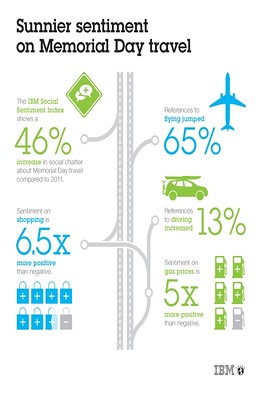
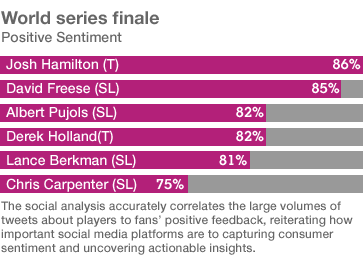
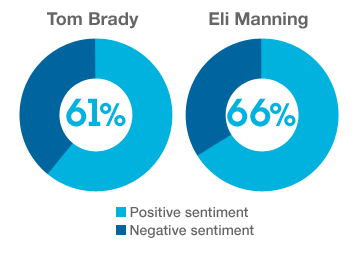
People in the U.S. are feeling better about the coming Memorial Day weekend than they did a year ago, according to an IBM study. As a result they may have bigger travel and shopping plans for the unofficial kickoff of the summer road-trip and vacation season.
Through an analysis of social media sentiment IBM found a significant increase in the number of people talking about travel and spending. The IBM Social Sentiment Index, uses analytics and language processing technology to identify and gather consumer opinions from Twitter, blogs, message boards and other social media.
According to the index conversations about Memorial Day travel increased by 46% compared to 2011. This suggests travel providers could see a boost in business and transportation officials will have to deal with more traffic. The index also shows a 65% rise in people mentioning traveling by air while discussion of driving increased 13%.
IBM said consumer sentiment regarding gasoline prices is surprisingly positive considering the average price of a gallon of regular gas, while 13 cents lower than a year ago, is still high at $3.71 according to the U.S. Energy Information Administration. Social media showed a five-to-one ratio of positive to negative mentions about gas in 2012 compared to a one-to-one ratio in 2011. These trends may indicate people are more confident about their finances this year.
Warren Buffett doesn’t buy Google.
Last week, he didn’t buy Facebook, the social-media phenomenon that started trading Friday on the Nasdaq, ending the day with a market capitalization of about $105 billion.
"I kind of ventured quite a ways out to buy IBM," Buffett said in an interview with the Fox Business cable network. "Facebook would be — my doctor would require a checkup."
No, Buffett puts money in things he understands. Among them: trains, insurance and newspapers.
Yes. Newspapers.
Atop his shopping list last week was a cluster of Southern newspapers in an industry that is — as Buffett himself said during this month’s shareholders meeting of Berkshire Hathaway Inc., his $200 billion company — declining.
In fact, he agreed to put $142 million in newspapers, buying the Winston-Salem Journal and all but one of Media General Inc.’s newspapers in a deal announced last week.
"Warren Buffett is the guy who orchestrated this transaction," said Terry Kroeger, president of BH Media Group, a holding company set up by Berkshire.
Efforts to contact Buffett were unsuccessful. In previous interviews, Buffett has said newspapers can do fine as long as they provide content that no one else does, and as long as they don’t provide it for free.
When the transaction goes through, probably by June 25, the ownership structure will have a few layers.
Kroeger said BH Media owns World Media Enterprises, which will be the actual owner of the Journal and 62 other dailies and weeklies in Virginia, North Carolina, South Carolina and Alabama, in addition to digital assets, including websites and mobile and tablet applications.
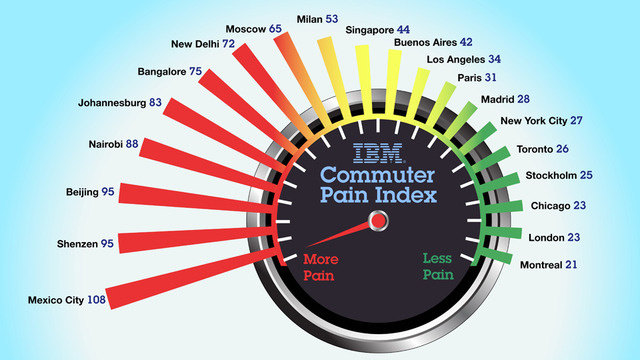
IBM’s "Commuter Pain 2011" survey doesn’t look at the causes of congestion or offer any solutions. Too difficult. Instead, IBM merely asks people how they commute and how much their commute sucks. Congratulations Mexico City, you suck and you know it.
The chart above shows how people in 20 cities react to their commute, with drivers in China and Russia describing traffic that sounds like the premise of a Jacques Tati movie. More than a quarter of respondents in Moscow claim to have spent more than three hours stuck in traffic. And we all know how crazy China is.
Tellingly, the 8,042 people surveyed were people who lived in a major city, were 18-65 years old, and drove a vehicle alone as their main mode of transportation. Considering there are decent transit options in most of these places it means IBM interviewed the people who were mostly to blame for their own congestion.
The Inrix study shows that drivers in other major cities are still spending a fair number of hours stuck in traffic, too. While Los Angeles ranked a close second to Honolulu, those in San Francisco spent almost 48 additional hours in the car because of traffic.
The news wasn’t all bad, though. Inrix says overall congestion was down 30 percent in 2011 from the year before, and notes that of the 100 cities it surveyed, 70 of them logged lower rates of congestion year over year.
These cities had the worst traffic in 2011, according to Inrix, which lists the average hours wasted per driver after each city:
10) Chicago – 32.8 hours
9) Boston – 35 hours
8) Austin – 30 hours
7) Seattle – 33 hours
6) Washington, D.C. – 45 hours
5) Bridgeport, CT – 42 hours
4) New York – 57 hours
3) San Francisco – 48 hours
2) Los Angeles – 56 hours
1) Honolulu – 58 hours
The study also finds that, nationally, the worst morning commute occurs on Tuesday, while the worst evening commute is on Friday.
.- Western military aid to Syrian rebels could prove disastrous for the country, according to the Damascus-based head of the Melkite Greek Catholic Church.
“It is time now to have some accord,” Patriarch Gregorios III told CNA on March 15, “and not to arm the opposition, not to attack the regime.”
There is a window of opportunity, he said, to “call both sides” to negotiate and prevent a civil war. But if this opportunity passes, “it will be more difficult because the opposition will be united, maybe more armed, and then more blood. Then it is finished.”
“In order to avoid this very, very sorrowful, very dark end, let us go the way of concord, of dialogue.”
The Eastern Catholic leader spoke to CNA shortly after he met with Pope Benedict XVI at the Vatican, to discuss the Church’s prospects in the midst of a conflict that is drawing worldwide attention.
That same day, the Patriarch confirmed that Pope Benedict would be visiting Lebanon from Sept. 14-16, with the possibility of a stop in Syria “if the situation improves.”
Syrian Christians and other religious minorities are concerned about what the future may hold, if the regime of President Bashar al-Assad collapses. The worst-case scenario is a power struggle between different Muslim groups, as has occurred in Iraq.
But Patriarch Gregorios believes there are alternatives to a sudden regime change that could plunge the country into chaos. He is also convinced that the Church can help the cause of peace in the “shaken Arab world” at large.

— Carl Anderson is CEO of the Knights of Columbus
he topic of religious liberty has been in the headlines a great deal recently, and in two weeks it will be on the big screen as well.
Years in the making, the film For Greater Glory tells the story, which has been all but forgotten, of the Mexican government’s persecution of the Catholic Church. It is a story of exiled bishops, murdered priests, and eventually a civil war: a war fought over religious freedom.
Americans of all faiths should watch this film. And they should thank God that they live in the United States, in a country ruled by law, where our differences are decided in courtrooms and with ballots rather than bullets.
Threats to religious freedom everywhere have certain similarities. A government attempts to take away from its people a fundamental right. It attempts to redefine how its people can think. In Mexico in the late Teens and Twenties, enforcement of the laws was violent, and violence begot more violence, and soon the entire country was engulfed in a civil war.
Nearly nine decades later, in the United States, a country that functions under the rule of law, we will protect our rights very differently. When people of faith in the United States respond to government intrusion into our First Amendment right of the free exercise of religion, we do so with civility, and with the knowledge that courts and elections have power to effect change.
For Greater Glory is a stark reminder that not every country has the stability, meaningful enfranchisement, and legal recourse that we enjoy here in the United States.
Mexico in the early 20th century was a turbulent place. Governments and revolutions came and went — violently and frequently. But the Catholic faith, to which the overwhelming majority of Mexicans adhered, held the country together.
Then in 1924 the Mexican government moved to suppress that faith. With the election of Plutarco Eliás Calles as president, it began to enforce anti-Catholic provisions of the 1917 constitution that had mostly been in abeyance until then. One of the government’s first assaults on religious liberty was its attempt to control who could serve as clergy. Foreign priests were expelled — or killed. Clergy were required to register with the government, which reserved the right to determine who counted as a priest.
Next came the move to ban religion from public view. Citizens were told they could “worship” freely, but privately. Priests who wore clerical attire outside their churches or rectories faced large fines. A priest who criticized the government could be jailed for five years, and priests were arrested or killed just for serving their flocks. Catholic organizations, with the blessing of their bishops, started resisting — peacefully at first, but then with arms when they were attacked. The violence snowballed, and soon Mexico was in the grip of a civil war.
.jpg)
In my opinion, IBM is the best stock to buy. It has a clear strategy, you know the end goal of the company. A smarter planet solution implementation. A business Analytics Comapny with a clear strategic future. Unlike many of the new startups, one question do you know where google, facebook, HP, will be doing in 5 years from now? How much is the public involve in its growth & decision making? Who knew that the interface of facebook would change dramtically in 1 year. Would you recognize google 2 years ago business model and today approach? I have to give them a lot of credit because theese genius of new CEO brought their companie to complete success.
The fact that worries me, is that in 5 years from now it really depends on these CEO strategy. I can guarantee in 5 years from now you will find IBM still focus on the same growing strategy. Tha is being a comapny that interconnect the business and IT world.
In 5 years from now you know where IBM will be. Delivering smarter solutions, and transforming government & cities into smarter cities interconnected to reduce Electrecity, erney and Water cost.
Listing in 1916, IBM is the original poster child for technology boom and bust. After eight years on the New York Stock Exchange as Computing Tabulating Recording Corporation, the company changed its name to International Business Machines and ushered in a period of extraordinary growth – becoming a kind of early 20th century equivalent of Apple.
Between 1927 and 1929, demand for its time cards and accounting machines helped to more than quadruple its value from $54 a share to a peak of $216 shortly before the Wall Street crash.
Then, along with the rest of the market, it came a cropper. By 1932, IBM’s share price had sunk to just $9.125.
Its then-president, Thomas Watson, declared that IBM would spend its way through the slump, investing $1bn in research and development and keeping its factories running at full speed even though it meant stockpiling computers in warehouses. It was a high-risk strategy, but one that paid off and helped propel IBM shares steadily higher until the early 1980s.
The company raised cash through a series of share splits, such that one share in 1924 would by now have proliferated to 3,460, worth more than $500,000 and nearly $9,000 in annual dividends.
Last month, IBM posted Q1 profits of $3.1bn on revenues of $24.7bn
We’re off to the races as Facebook (FB) begins to trade; the stock has trimmed most of its gains after initially surging more than 10 percent in its debut on the Nasdaq.
This is a good time to compare the giant social network with some of the other well-known tech outfits of the modern day, such as Google (GOOG), Microsoft (MSFT) and Apple (AAPL).
Now, anyone who remembers the dot-com era certainly recalls bust after bust, but the tech sector is also full of success stories. And some of the best-known companies in technology have made it for a reason: They provide something people want, and the businesses are run the right way. Shareholders in these particular companies have done well, too. In a number of cases, they’ve done astonishingly well.